Owls don t have eyeballs

Owls don’t have eyeballs.

Introduction
Owls, often regarded as mysterious and fascinating creatures, have many unique features that set them apart from other birds. One such intriguing fact about owls is that they don’t possess eyeballs as most other animals do. In this article, we will delve into this captivating characteristic of owls, exploring the structure and function of their eyes and how it contributes to their exceptional hunting abilities.
Adaptation for Night Vision

The Eyes of an Owl
Unlike humans and many other birds, owls have evolved specialized characteristics enabling them to excel in low-light conditions during the night. While they do not possess conventional eyeballs, owls have large, tubular, and immobile eye structures that are fixed in position within deep eye sockets. These tubular eyes contribute to their remarkable visual capabilities, which are vital for navigating and hunting in darkness.
Unique Eye Structure
The tubular eyes of owls are elongated, which provides them with a more extensive visual field compared to humans and other diurnal animals. Additionally, these eyes are unable to move independently like ours; instead, owls must rely on turning their heads to adjust their field of view. This characteristic is often associated with the iconic ability of owls to rotate their heads nearly 270 degrees.
Enhanced Depth Perception
Owls exhibit exceptional depth perception, mostly owing to the structure of their eyes. The placement and forward-facing positioning of their eyes allow for overlapping fields of vision, similar to humans. This overlapping vision creates a stereoscopic effect, aiding their precise evaluation of distances between objects and enabling them to accurately judge the location of their prey, even in the darkest of nights.
Increased Light Gathering Capability
Another notable feature of owl eyes is their ability to gather and process minimal amounts of light. Light-sensitive cells called rod photoreceptors are densely concentrated in the retina of the owl’s eye. This concentration allows the owl’s eyes to collect and interpret faint traces of light more effectively. Consequently, even in conditions where humans would struggle to see anything, owls can essentially navigate and hunt with exceptional clarity.
Conclusion
Owls possess remarkable eyes that enable them to adapt and thrive in nocturnal environments. Their tubular eye structure, fixed position, overlapping fields of vision, and enhanced light gathering capabilities all contribute to their exceptional hunting abilities. Despite not having conventional eyeballs, owls have evolved ingenious adaptations that allow them to become efficient nighttime predators. Next time you encounter an owl, remember the extraordinary capabilities hidden within its unique tubular eyes—the key to its success in the dark of the night.
Related Posts
Quick Links
Legal Stuff

